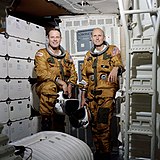STS-3
| Mission emblem | |||
|---|---|---|---|

|
|||
| Mission dates | |||
| Mission: | STS-3 | ||
| COSPAR-ID : | 1982-022A | ||
| Crew: | 2 | ||
| Begin: | March 22, 1982, 16:00:00 UTC | ||
| Starting place: | Kennedy Space Center , LC-39A | ||
| Landing: | March 30, 1982, 16:04:46 UTC | ||
| Landing place: | White Sands , Lane 17 | ||
| Flight duration: | 8d 0h 4m 46s | ||
| Earth orbits: | 130 | ||
| Track height: | 249 km | ||
| Orbit inclination : | 38.0 ° | ||
| Covered track: | 5.3 million km | ||
| Payload: | OSS-1 | ||
| Team photo | |||
 Jack Lousma (left) and Gordon Fullerton |
|||
| ◄ Before / After ► | |||
|
|||
STS-3 ( english S pace T ransportation S ystem ) is a mission designation for the US Space Shuttle Columbia (OV-102) NASA . The launch took place on March 22, 1982. It was the third space shuttle mission and the third flight of the space shuttle Columbia.
team
- Jack Lousma (2nd space flight), commander
- Gordon Fullerton (1st spaceflight), pilot
In the original plans of NASA, Fred Haise was intended as the commander and Lousma as the pilot; they should fly to the Skylab space station and bring it to a higher orbit to save it from falling. When delays in the shuttle program and an unexpectedly rapid loss of altitude of Skylab thwarted these plans, Haise left NASA in June 1979, shortly before the Skylab crash. Thereupon Lousma, who had spent two months aboard Skylab in 1973, was promoted to commandant. Fullerton, together with Haise, formed one of the two teams for the Approach and Landing tests for the space shuttle in 1977 .
Substitute team
- Thomas Mattingly , commandant
- Henry Hartsfield , pilot
STS-3 was the last NASA flight for which a full replacement crew was assigned. From STS-4 onwards, substitutes were only nominated for individual team members. This mainly affected payload specialists and astronauts from other countries.
Mission overview
STS-3 was the penultimate test flight of the space shuttle program. The focus was on checking the thermal resistance of the orbiter. Various areas of the Columbia were exposed to the sun for extended periods of time, and radiation levels were measured. Experiments for NASA's Office of Space Science were on a pallet in the cargo bay. OSS-1 collected data about the near-Earth environment, including contaminants (gases, dust, etc.) that were brought into space by the orbiter itself. In addition, the robot arm had its second use.
In contrast to the STS-1 and STS-2 , the outer tank was not painted white for weight reasons. From this mission onwards it remained in its original red-brown color.
STS-3 was the only mission of the shuttle program, with a landing in White Sands ( New Mexico went) to an end because of rain, the originally planned runway at California's Edwards Air Force Base had softened. Just before the flight began, NASA decided to land the shuttle in White Sands. Edwards was to serve as an alternate landing site. However, the moisture did not evaporate as quickly as expected and so, while the mission was already running, the concrete runway of the Kennedy Space Center ( Shuttle Landing Facility ) was designated as the second landing site. Since the track in White Sands is made of natural plaster of paris, the Columbia was heavily contaminated by blown dust while it was being rolled out. The ferry then had to be cleaned at great expense. On April 6, 1982, Columbia returned to the Kennedy Space Center on the Shuttle Carrier Aircraft .
See also
Web links
- NASA Mission overview (English)
- Video summary with comments of the crew (English)
